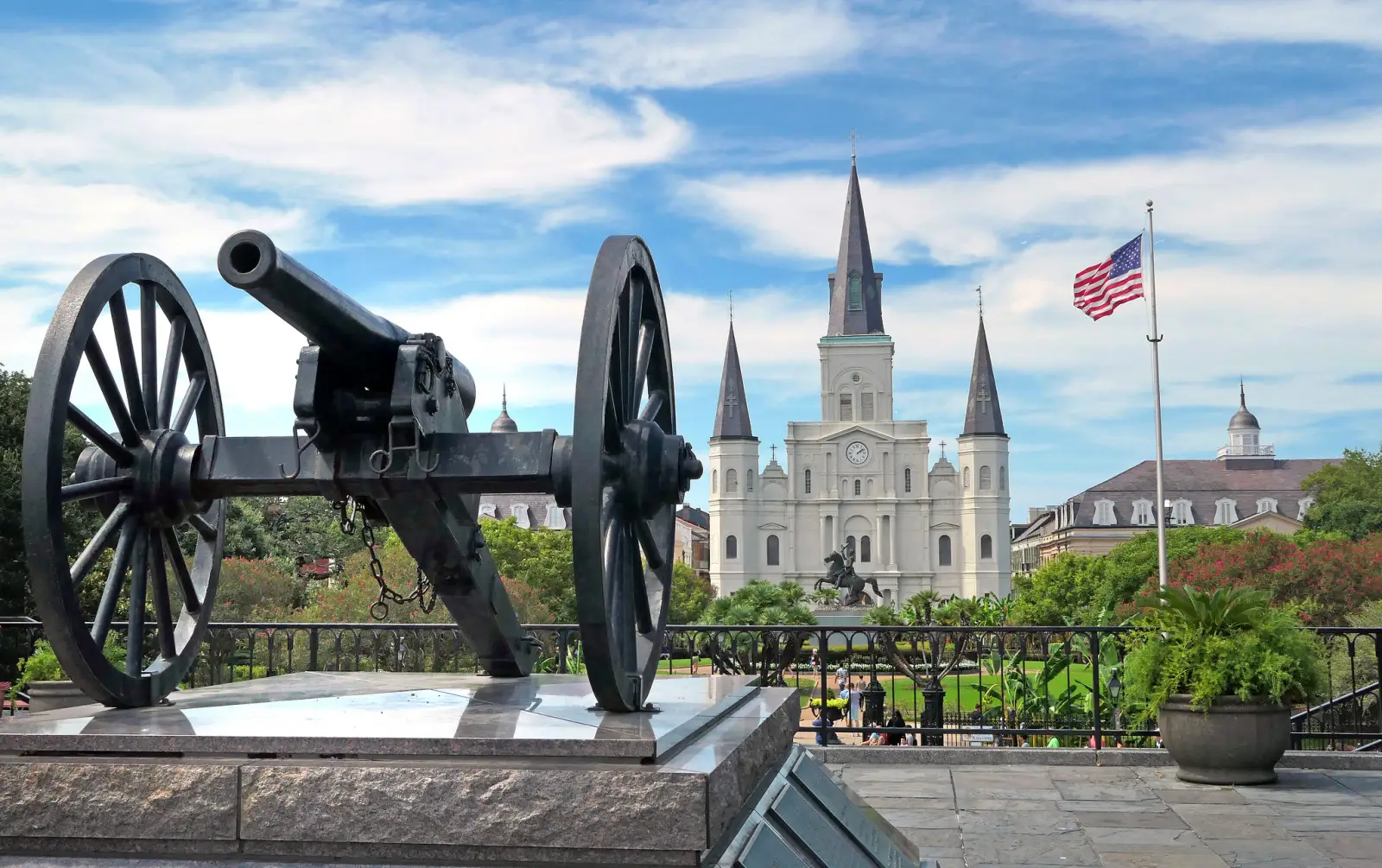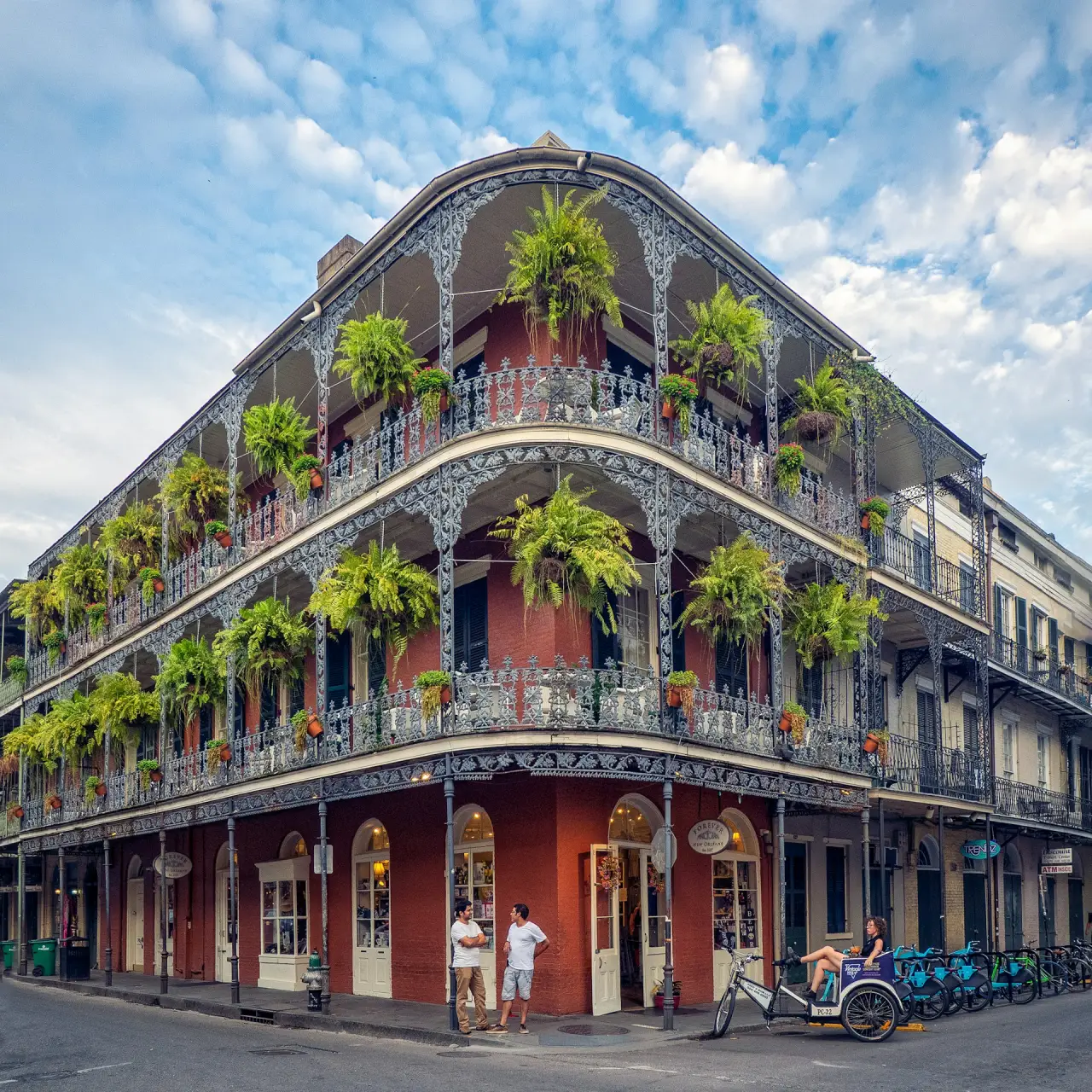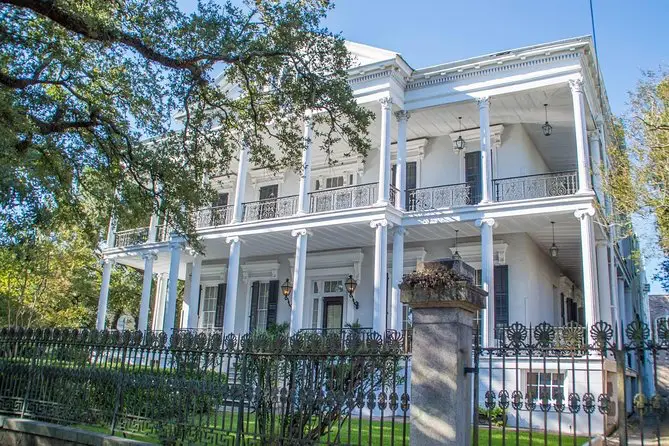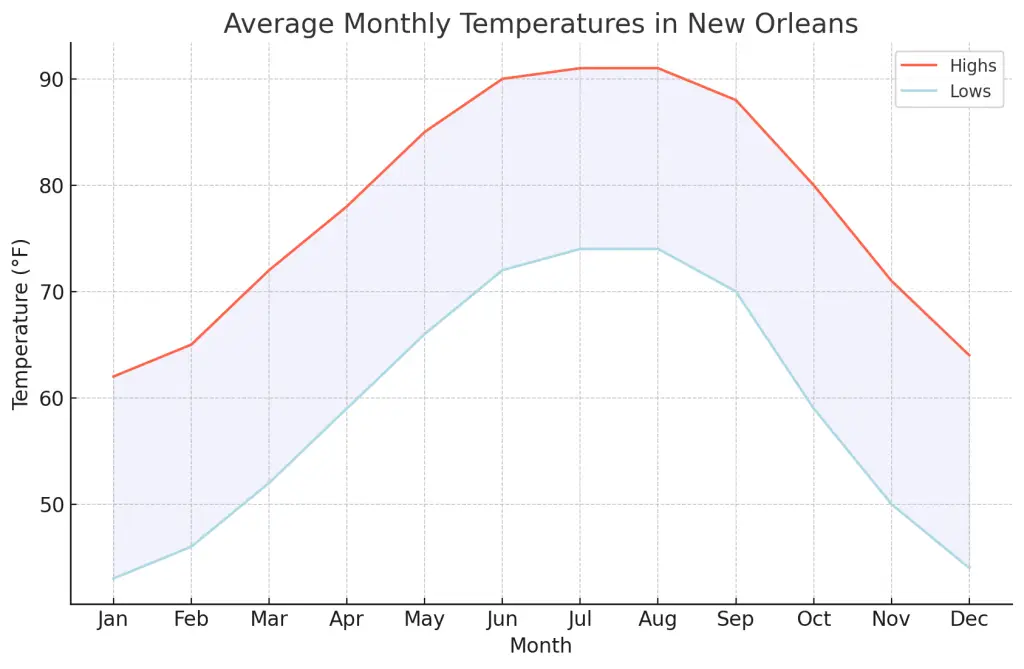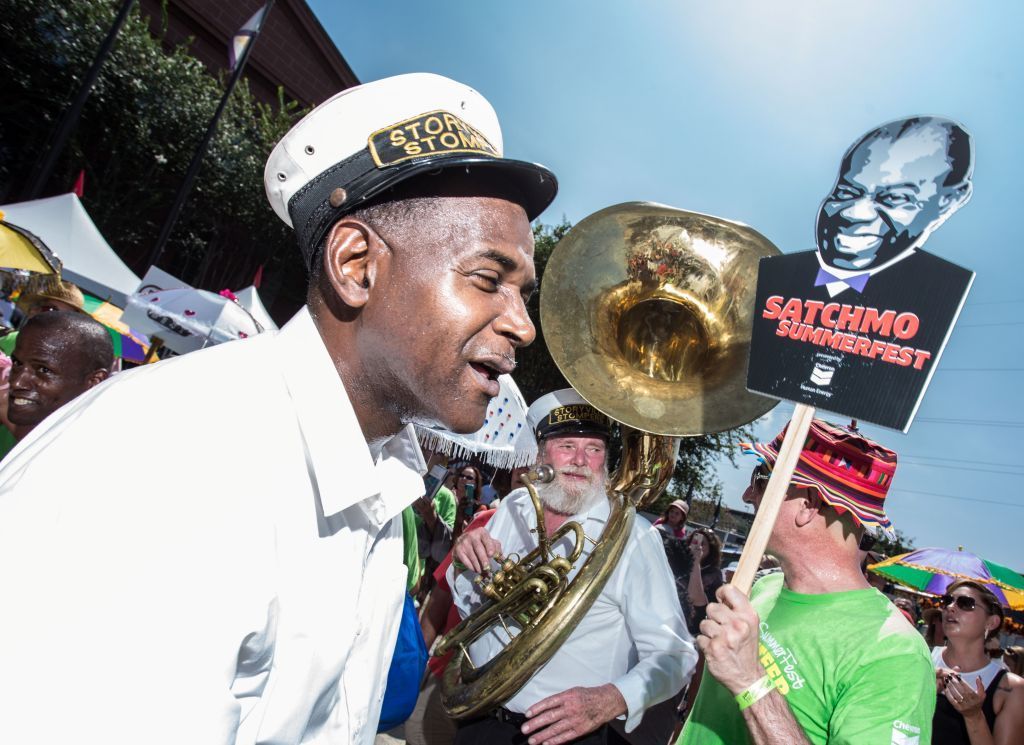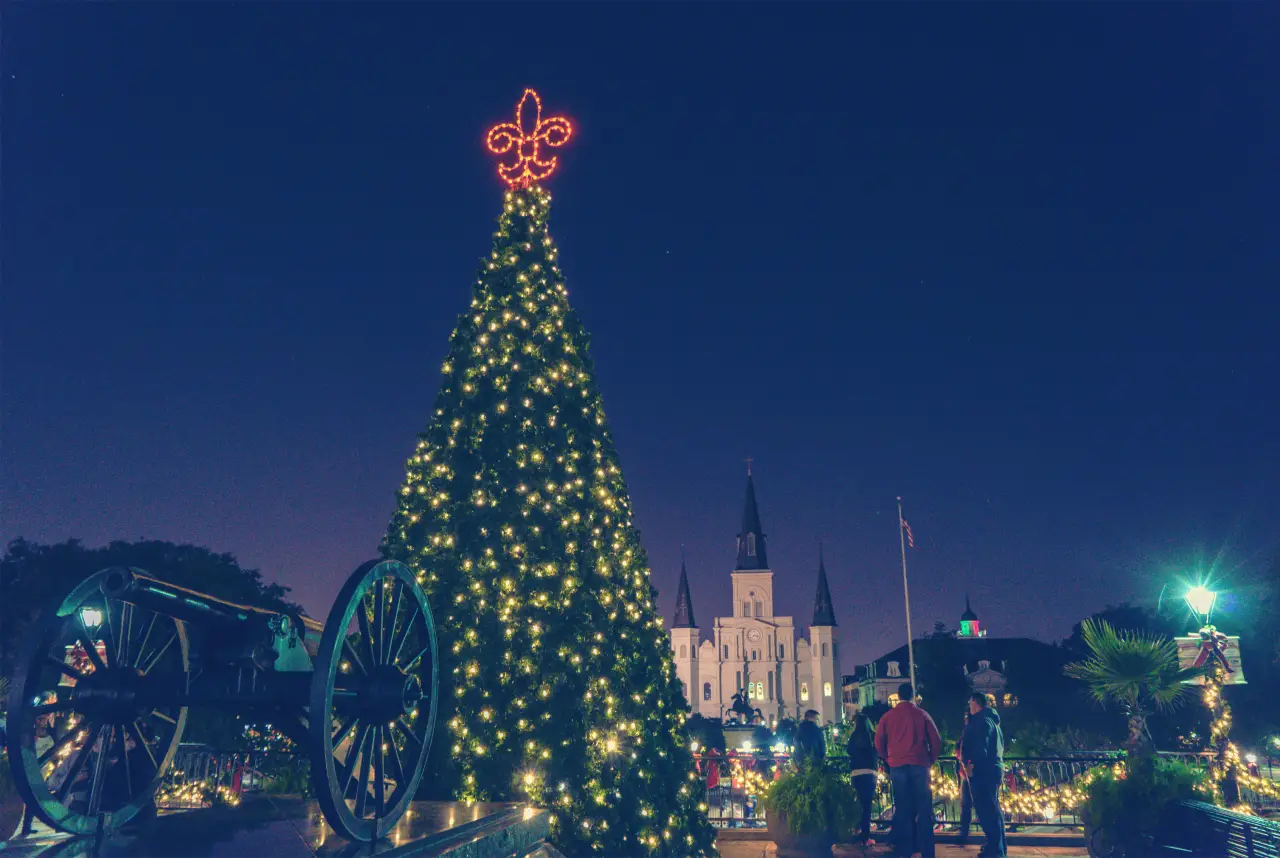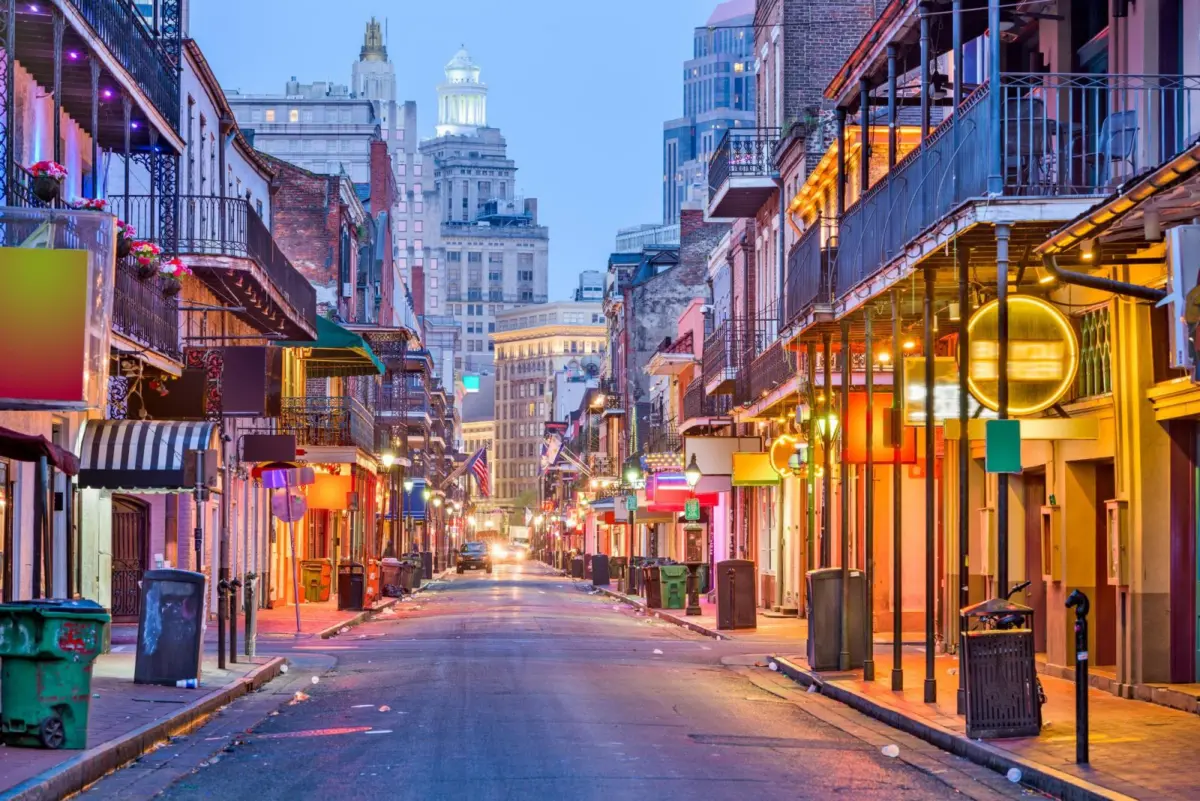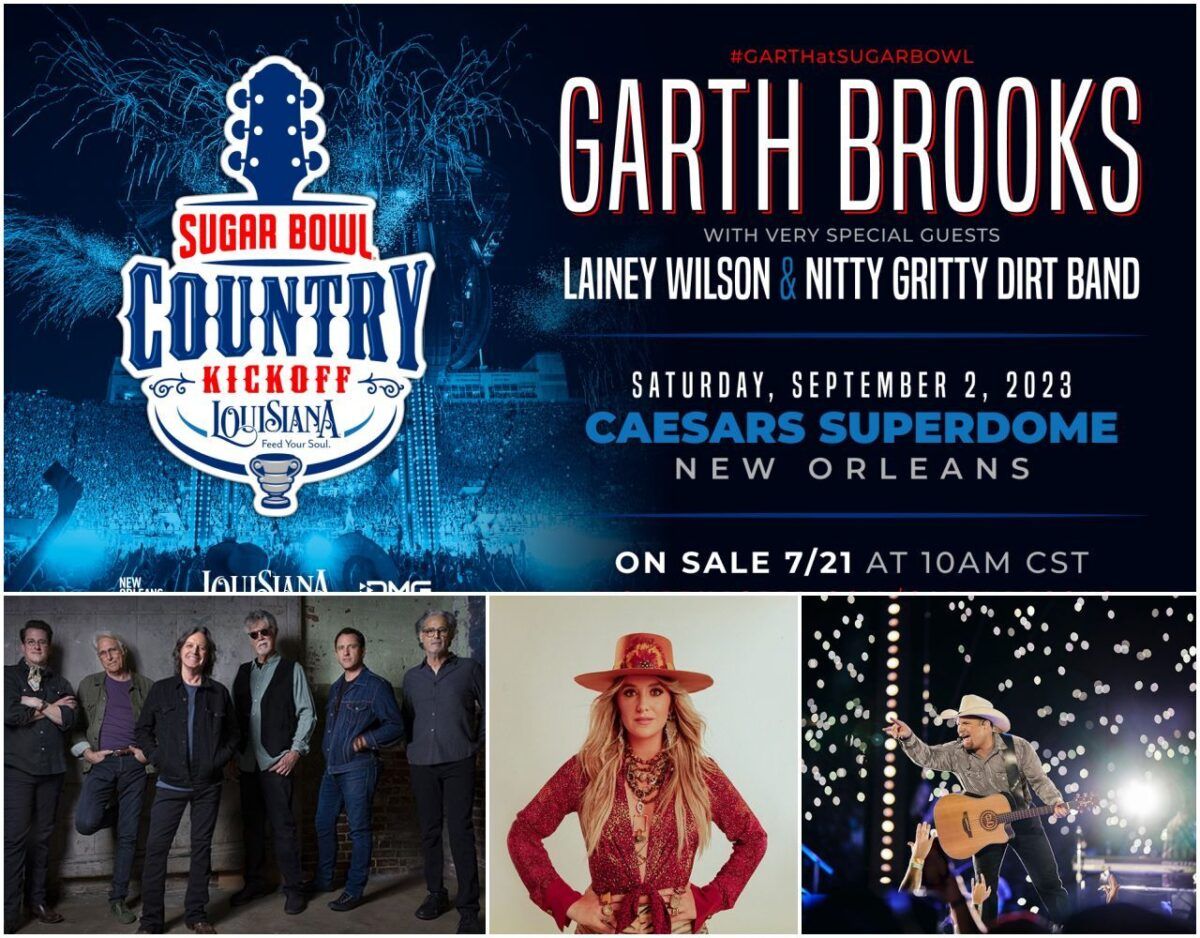Whether you’re a first-timer, someone who’s heard countless stories but has never set foot in New Orleans, or a seasoned visitor looking to delve deeper into the city’s vibrant culture, this article is your gateway.
New Orleans, with its captivating European-style architecture, exquisite Creole cuisine, and an atmosphere brimming with good vibes, calls out to the heart of every travel enthusiast. As the celebrated birthplace of jazz, the city is a melodic treasure trove, echoing with the sounds of blues, rock ‘n’ roll, and zydeco from every corner.
While the iconic Mardi Gras, with its flamboyant parades and festive spirit, might be the most famous draw, New Orleans’ calendar is packed with events and festivals all year round, offering endless opportunities for exploration and celebration.
Get ready to experience the soulful rhythm and infectious energy of New Orleans, a city that promises unforgettable adventures at every turn.
New Orleans, a city of vibrant culture, rich history, and diverse neighborhoods, beckons travelers with its unique blend of French, African, Spanish, and American influences. From the lively streets of the French Quarter to the serene beauty of the Garden District, New Orleans offers an experience unlike any other.
Why is New Orleans called NOLA?
The answer to this question might be known by many Americans and some travel enthusiasts, but it is impossible not to explain it for those who do not know.
New Orleans is called “NOLA” as an abbreviation of its full name, New Orleans, Louisiana. The acronym combines the city’s initials (NO) with the abbreviation for the state of Louisiana (LA),
It creates a catchy and convenient shorthand that’s widely recognized and used by both locals and visitors alike.
OK, now we are ready to start our exploration of NOLA!
Starting Point: The French Quarter
The French Quarter, or Vieux Carré is the heart and soul of New Orleans. It is the oldest neighborhood in the city. The French Quarter is also a National Historic Landmark that captures the enduring essence of New Orleans.
Established by the French in 1718, this historic heart was where the original New Orleans colony sprang to life, meticulously preserving its rich heritage through the ages. Today, the area proudly displays its lineage, with street names echoing their French origins, inviting wanderers to traverse its narrow, cobblestone paths. History buffs can deep dive into details here
Things to do in the French Quarter
Stroll Down Bourbon Street: The heart of New Orleans’ nightlife, Bourbon Street is essential for anyone looking to experience the vibrant energy of the French Quarter. With bars and clubs featuring live music from jazz to contemporary beats, it’s the epicenter of entertainment in the city.
Embark on a journey through these timeless streets, and you’ll be greeted by an array of iconic sights such as the majestic Jackson Square, the literary haven of Faulkner House Books, and the historic Cabildo, each telling its own story of the city’s multifaceted past.
As you meander, let your gaze wander upwards to the intricate baroque ironwork of the balconies, adorned with lush hanging plants, or find tranquility in the secluded leafy courtyards, where bubbling fountains add to the enchantment of the surroundings.
If you’re looking for a no-holds-barred fright in New Orleans, explore the city’s dark history on this adults-only tour from Hottest Hell, one of the top-rated haunted tour operators in town. Your frightful tour of one of the country’s most haunted cities begins in central New Orleans.
Indulge in Culinary Delights: Sample the rich flavors of Creole and Cajun cuisine at some of the Quarter’s famous restaurants and cafes. Must-try dishes include beignets, gumbo, and jambalaya, offering a taste of local culinary tradition. GW Fins, a standout dining establishment between Bourbon and Dauphine Streets, is renowned for its exceptional seafood and sophisticated atmosphere. It has been serving up the freshest fish in New Orleans since it opened in 2001, and the menu changes daily depending on what was caught that morning.
Discover Live Music Venues: As the birthplace of jazz, the French Quarter boasts countless venues showcasing live performances. From the traditional jazz at Preservation Hall to the diverse sounds found along Bourbon Street, music lovers are in for a treat.
Explore Iconic Landmarks: Visit must-see attractions like Jackson Square, with its historical significance, and St. Louis Cathedral, a beacon of history and spirituality. The bustling French Market offers unique shopping and dining experiences, while serene courtyards provide a peaceful retreat.
Experience Art and Museums: The Quarter is home to numerous galleries and museums that celebrate the art, history, and culture of New Orleans. These cultural institutions provide a deeper understanding of the city’s heritage and artistic expression.
Participate in Festivals and Events: Engage with the local culture by attending one of the many festivals and events held in the French Quarter. From Mardi Gras to food, music, and art festivals, there’s always something to celebrate.
Indeed, the French Quarter’s allure is undeniable, drawing visitors into its charming embrace. However, this charm comes with a note of caution for the budget-conscious traveler, as residing in any of the French Quarter’s exquisite hotels can lean towards the pricier side. Or you can take a unique opportunity to experience cutting-edge amenities, contemporary design, and unparalleled service at one of these new hotels in New Orleans. Yet, whether you choose to indulge in the luxury of these historic lodgings or simply soak up the beauty and history on a leisurely stroll, the French Quarter promises an experience rich in culture, architecture, and the timeless spirit of New Orleans.
The Garden District
If you’re looking to escape the hustle and bustle of the French Quarter hop on the St. Charles Streetcar and take in the Garden District’s antebellum mansions.
Welcome to the Garden District, New Orleans’ picturesque neighborhood that whispers tales of the past amidst its stunning array of architectural marvels and verdant, leafy streets. This enchanting area, known for its well-preserved Victorian mansions, Greek Revival homes, and lush gardens, stands as a testament to the city’s rich history and cultural diversity.
Established in the 19th century as a residential haven for the wealthy, the Garden District today invites visitors to explore its serene beauty and architectural grandeur.
Here, the air carries a sense of tranquility and elegance, offering a peaceful retreat from the vibrant energy of the French Quarter.
As you wander through the Garden District, you’ll find yourself captivated by the intricate details of each home, the story behind every wrought-iron gate, and the inviting shade of ancient oaks.
Things to do in the Garden District
Discover Architectural Wonders: Embark on a journey through the Garden District’s leafy avenues lined with opulent Victorian mansions, Greek Revival homes, and Italianate estates. Each structure tells a story of the area’s affluent past, with intricate designs and lush gardens that beckon for admiration.
Shop and Dine on Magazine Street: This bustling thoroughfare is the heart of the Garden District’s shopping and dining scene. Explore boutique shops offering unique finds, from vintage clothing to handmade jewelry. Savor the flavors of New Orleans at cozy cafes and renowned restaurants dotting the street.
Take a Guided Walking Tour: Experience the rich history and architectural beauty of the Garden District up close with a guided walking tour. Expert guides will lead you through the neighborhood’s most fascinating spots, sharing stories of historical figures and celebrities who have called these streets home.
Visit Lafayette Cemetery No. 1: Step into the hallowed grounds of one of New Orleans’ oldest cemeteries, Lafayette Cemetery No. 1. Its above-ground tombs and ancient oaks offer a glimpse into the city’s unique burial practices and the area’s history.
Immerse Yourself in Local Culture: The Garden District is not just a showcase of architectural beauty; it’s a living, breathing community. Attend local events, markets, and festivals to connect with the vibrant culture and warm hospitality of its residents.
Relax in Lush Gardens and Green Spaces: Find solace in the serene gardens and public parks scattered throughout the neighborhood. These green oases offer a tranquil escape, perfect for leisurely strolls or picnics under the shade of majestic trees.
Capture the Beauty: Don’t forget your camera, as the Garden District offers endless photographic opportunities. From the detailed facades of historic homes to the charming streetscapes, every corner presents a visual treat.
Other New Orleans Neighborhoods to Explore
Marigny and Bywater: Adjacent to the French Quarter, these neighborhoods boast a vibrant arts scene, eclectic dining options, and colorful Creole cottages. The area is known for its laid-back atmosphere and is a favorite among artists and musicians. Bywater, sits on the Mississippi River, bordering the Marigny. It’s slightly quieter than the Marigny and here you will find NOLA’s best galleries and vintage shopping.
Tremé: One of the oldest African American neighborhoods in the United States, Tremé is rich in cultural history and musical heritage. It’s home to several important museums, including the New Orleans African American Museum, and is a must-visit for those interested in the roots of jazz.
Warehouse District: Also known as the Arts District, this area is teeming with art galleries, museums, and trendy restaurants. Once an industrial area, it has been transformed into a hub for contemporary art and cuisine.
Uptown and Audubon: This expansive area includes the Audubon Park and Zoo, Tulane and Loyola universities, and the famous St. Charles Avenue, lined with majestic oak trees and stately mansions. Uptown offers a glimpse into the more residential side of New Orleans life.
Mid-City: Known for its laid-back vibe, Mid-City is home to City Park, the New Orleans Museum of Art, and the Bayou St. John. This neighborhood is perfect for those looking to explore outdoor activities and enjoy local cuisine at casual eateries.
Algiers Point: Located across the Mississippi River from the French Quarter, Algiers Point offers stunning city skyline views, historic homes, and a quiet, small-town feel within the city. It’s accessible by ferry and provides a unique perspective on New Orleans.
Gentilly: Blending urban and suburban, Gentilly is home to the beautiful Lake Pontchartrain shoreline, diverse architectural styles, and a mix of family-friendly parks and restaurants. It’s known for its relaxed atmosphere and sense of community.
Lakeview: Situated near Lake Pontchartrain, Lakeview is a residential neighborhood known for its outdoor recreation opportunities, including boating and fishing, as well as its family-friendly atmosphere and local dining spots.
Weather in NOLA
Weather in New Orleans is characterized by its subtropical climate, meaning the city experiences hot, humid summers and mild, wet winters. During the summer months, from June to August, temperatures frequently rise into the 90s°F (about 32-37°C), coupled with high humidity levels, making it feel even hotter. Afternoon thunderstorms are common, providing temporary relief from the heat.
Spring (March to May) and fall (September to November) are considered the most pleasant times to visit New Orleans, with temperatures ranging from the mid-60s to the mid-80s°F (about 18-29°C). These seasons offer a comfortable climate, perfect for exploring the city’s outdoor attractions and festivals.
Winter in New Orleans, from December to February, is mild compared to much of the United States, with daytime temperatures usually in the 50s and 60s°F (about 10-20°C). However, cold fronts can occasionally bring cooler temperatures, and rain is relatively common during these months.
Overall, New Orleans’ weather allows for year-round outdoor activities, though visitors should be prepared for the heat and humidity if they plan to visit in the summer.
Best times to visit NOLA
The best times to visit New Orleans are during the spring months of February to May and the fall months of October to November.
These seasons offer comfortable temperatures and host the city’s most famous festivals, including Mardi Gras and the New Orleans Jazz & Heritage Festival in spring, and various food and music events in fall.
Is it safe to visit New Orleans?
Like visiting any other popular city that attracts thousands of people requires some level of caution and awareness of your surroundings. The city has areas that are perfectly safe for tourists, especially during the day and in well-traveled neighborhoods such as the French Quarter, Garden District, and areas around major tourist attractions.
How to Stay Safe in New Orleans?
However, it’s advisable to stay vigilant, especially at night, and stick to well-lit, populated areas. Streets farther away from the more tourist-friendly areas suffer from poor lighting and may be unsuitable to visit on foot after dark.
Avoid walking alone late at night and be cautious when using ATMs. Using common sense safety practices—such as not displaying valuables openly, being aware of your surroundings, and using reputable transportation services—can go a long way in ensuring a safe visit. The best ways to get around New Orleans are on foot and by public transportation.
How to Get from New Orleans Airport to Downtown New Orleans?
To get into the city from the Louis Armstrong New Orleans International Airport (MSY) – located about 15 miles west of downtown New Orleans – you can use the schedule bus service or you can use taxis.
Bus Service to Downtown New Orleans from the airport is available via the Jefferson Transit Authority (JET) and the Regional Transportation Authority (RTA). Bus service is available from Level 1 Baggage Claim outside Door 2, Zones B4 and B5.
Jefferson Transit Authority (JET): The fare for the Veterans-Airport (E1) bus, operated by JET, is set at $2.00. Acceptable payment methods for the fare boxes include $1, $5, $10, $20 bills, as well as all denominations of U.S. coins. This bus route offers a connection from the Louis Armstrong New Orleans International Airport to Downtown, with the journey taking about 50 minutes.
Regional Transportation Authority (RTA): The RTA operates the Airport Express (202) Bus, which runs between the Louis Armstrong New Orleans International Airport and Downtown New Orleans. There are two downtown pick-up locations for the Airport Express (202) Bus: Elk Place at Cleveland and the Union Passenger Terminal at Bus Bay 2. The cost to ride on this service is $1.25.
Please note that only the Regional Ride day pass can be used on both JET and RTA systems.
There are also Airport Shuttle services. Please note that as of February 2023, the airport shuttle will no longer be contracting individual rides. Airport Shuttle service is available to and from Downtown and Uptown New Orleans hotels, the French Quarter, the Ernest N. Morial Convention Center and the Cruise Ship Terminals. The shuttles are located in the Ground Transportation Center, outside of Level 1 Baggage Claim Doors 1 through 5.
Uber and Lyft are also widely available. All ride app services pick up passengers outside of Level 1 Baggage Claim on the middle curb.
Taxis are available for passengers at a designated taxi loading area located on the Arrivals Curb, just outside Level 1 Baggage Claim at Door 7. The fare for taxi services from the airport to either the Central Business District (CBD) or the French Quarter (west of Elysian Fields) is set at $36.00 for one or two passengers. If there are three or more passengers, the cost is $15.00 per person. All taxis are mandated to accept payment via credit card.
What’s New and Not to Miss in New Orleans in 2024?
2024 promised an unusual and thrilling overlap, with Valentine’s Day on February 14th closely following Mardi Gras on February 13th, blending the spirits of romance and celebration uniquely.
Some other important events this year include:
- French Quarter Festival 2024: April 11-14, presented by Chevron and organized by FQFI, featuring over 70 music performance debuts, 16 new culinary experiences, nighttime After Dark programming, and two new stages, celebrating Louisiana’s vibrant spirit.
- Rolling Stones at Jazz Fest: Catch their only 2024 festival appearance on May 2, part of the New Orleans Jazz & Heritage Festival, now extended to eight days from April 25-28 and May 2-5.
- New Orleans Wine and Food Experience: It is a premier event, showcasing what the city does best… eating and drinking. In its 32nd Anniversary year, the festival (June 5-9, 2024) has become one of the most celebrated culinary events in the nation, attracting gourmands and connoisseurs.
- French Market Creole Tomato Festival: Celebrate the taste of summer with the Creole Tomato Festival. Celebrate Tomato Fest on June 8-9, 2024. Get fresh Creole tomatoes at the French Market, see live music, and enjoy many more family-friendly activities.
- Bocuse d’Or and Pastry World Cup: For the first time in the US, New Orleans hosts these prestigious culinary competitions from June 11-13, 2024, at the Ernest N. Morial Convention Center.
- Essence Festival of Culture’s 30th Anniversary: Celebrate from July 4-7, 2024, in New Orleans, featuring music, speakers, and conversations on culture and art.
- Taylor Swift’s Eras Tour in New Orleans: Three-night concert series in October 2024 at the Caesars Superdome, marking one of the final US stops.
- New Orleans Funk Fest 2024: From October 18th to 20th, immerse in Louisiana’s vibrant music legacy, featuring funk tunes, local cuisine, drinks, artisan crafts, and unique merchandise, all celebrating and sharing the state’s global musical influence.
For more events, tickets and programs visit the official New Orleans website.

